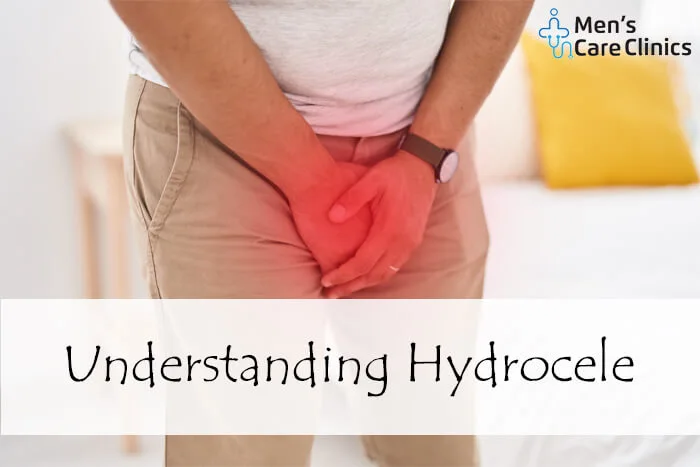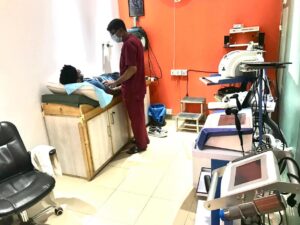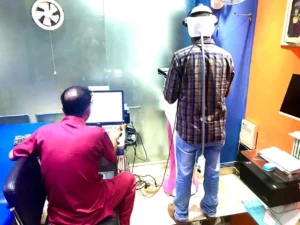The physical Examination, imaging studies, and the differential Diagnosis of Hydrocele.
Physical Examination
A. Visual Inspection:
Visual Inspection is the initial step in diagnosing a hydrocele. During this Examination, a healthcare provider carefully examines the scrotum’s external appearance. They assess for signs of scrotal swelling, noting the size, shape, and symmetry of the scrotal sac. In the case of a hydrocele, one side of the scrotum may appear larger or more distended than the other.
B. Transillumination:
Transillumination is a valuable diagnostic technique for distinguishing a hydrocele from other scrotal conditions. It involves placing a small, handheld light source against the scrotal skin. When a hydrocele is present, the scrotal sac will transmit light, causing it to appear as a translucent, glowing mass. This illumination is a hallmark sign of a hydrocele and aids identification.
C. Palpation:
Palpation involves gently feeling the scrotal sac to assess its texture and consistency. A hydrocele typically feels soft and fluid-filled when touched. The healthcare provider may also evaluate for tenderness, which can help differentiate a hydrocele from other scrotal conditions that may cause discomfort.
Imaging Studies
A. Ultrasound:
Scrotal ultrasound is a non-invasive imaging procedure that is often employed to confirm the Diagnosis of a hydrocele. High-frequency sound waves are used in an ultrasound to make clear pictures of the scrotal area. Healthcare professionals can see the size, form, and features of the hydrocele with this imaging method. It is also helpful in differentiating a hydrocele from other scrotal conditions, such as inguinal hernias or testicular tumors. Ultrasound is the diagnostic gold standard in the treatment of hydroceles.
B. Doppler Ultrasound:
Doppler ultrasound is an extension of scrotal ultrasound that assesses blood flow in the scrotal region. It is beneficial in cases where trauma or other conditions may have affected blood circulation within the scrotum. Doppler ultrasound can help identify vascular abnormalities or issues contributing to the scrotal swelling.
C. Magnetic Resonance Imaging (MRI):
While less commonly used, MRI may be recommended in certain situations. MRI gives clear, cross-sectional pictures of the scrotal structure. It is typically reserved for cases where ultrasound results are inconclusive or additional information is needed to determine the extent of the condition or rule out other abnormalities.
Differential Diagnosis:
During the diagnostic process, healthcare providers consider other potential causes of scrotal swelling, as the symptoms of various scrotal conditions can overlap. These conditions may include:
Inguinal Hernia: This type of hernia happens when abdominal or intestinal tissue pushes through a weak spot in the abdominal wall and into the scrotum or inguinal canal.
Varicocele: The term for enlarged veins in the scrotum, which are frequently compared to a “bag of worms.”
Testicular Torsion: An acute medical condition when the spermatic cord twists, severing the testicle’s blood supply and producing excruciating pain.
Epididymitis: Inflammation of the structure beneath the testicle, the epididymis, frequently accompanied by pain and swelling.
Testicular Tumors: Abnormal growths within the testicle that may present as scrotal swelling or a lump.
A thorough evaluation, including a combination of physical Examination, imaging studies, and consideration of other potential conditions, ensures that healthcare providers make an accurate diagnosis of hydrocele and develop an appropriate treatment plan based on the specific findings. Consider seeing a doctor right away if you think you have a hydrocele or scrotal swelling. They will be able to give you a complete exam and Diagnosis.
Monitoring
A. Regular Self-Examination:
Individuals with hydroceles can perform regular self-examinations to monitor the size and characteristics of the scrotal swelling. This involves gently feeling the scrotal sac and noting any changes in size, consistency, or discomfort.
B. Periodic Medical Check-Ups:
Even when pursuing conservative management, it is advisable to have periodic medical check-ups with a healthcare provider. They can perform thorough evaluations, confirm the stability of the hydrocele, and rule out any complications or other underlying conditions.
Home Care
A. Scrotal Support:
Wearing supportive underwear, such as briefs, can provide comfort and help reduce discomfort associated with the weight of the hydrocele. Scrotal support garments are available and can offer additional Support if needed.
B. Pain Management:
Over-the-counter pain relievers, such as acetaminophen (Tylenol) or nonsteroidal anti-inflammatory drugs (NSAIDs) like ibuprofen (Advil), can be used as directed to manage any mild discomfort or pain associated with the hydrocele.
C. Elevation:
Elevating the scrotum by placing a rolled-up towel or cushion under the scrotum while resting or sleeping may help reduce swelling and discomfort.
D. Warm Compresses:
Applying a warm, moist cloth or compress to the scrotum for short periods can help relieve discomfort and promote blood circulation.
Lifestyle Considerations
A. Limit Physical Strain:
Engaging in heavy lifting or strenuous physical exertion should be limited to prevent further discomfort or aggravation of the hydrocele. Rest and light activity may be preferable during the management phase.
B. Maintain Good Genital Hygiene:
Proper genital hygiene is essential to prevent any infection or irritation of the scrotal skin. Keep the scrotal area clean and dry to reduce the risk of complications.
C. Avoid Aggravating Factors:
Certain habits, such as smoking and excessive alcohol consumption, can contribute to fluid retention and may exacerbate the hydrocele. Consider lifestyle modifications to promote overall health and well-being.














